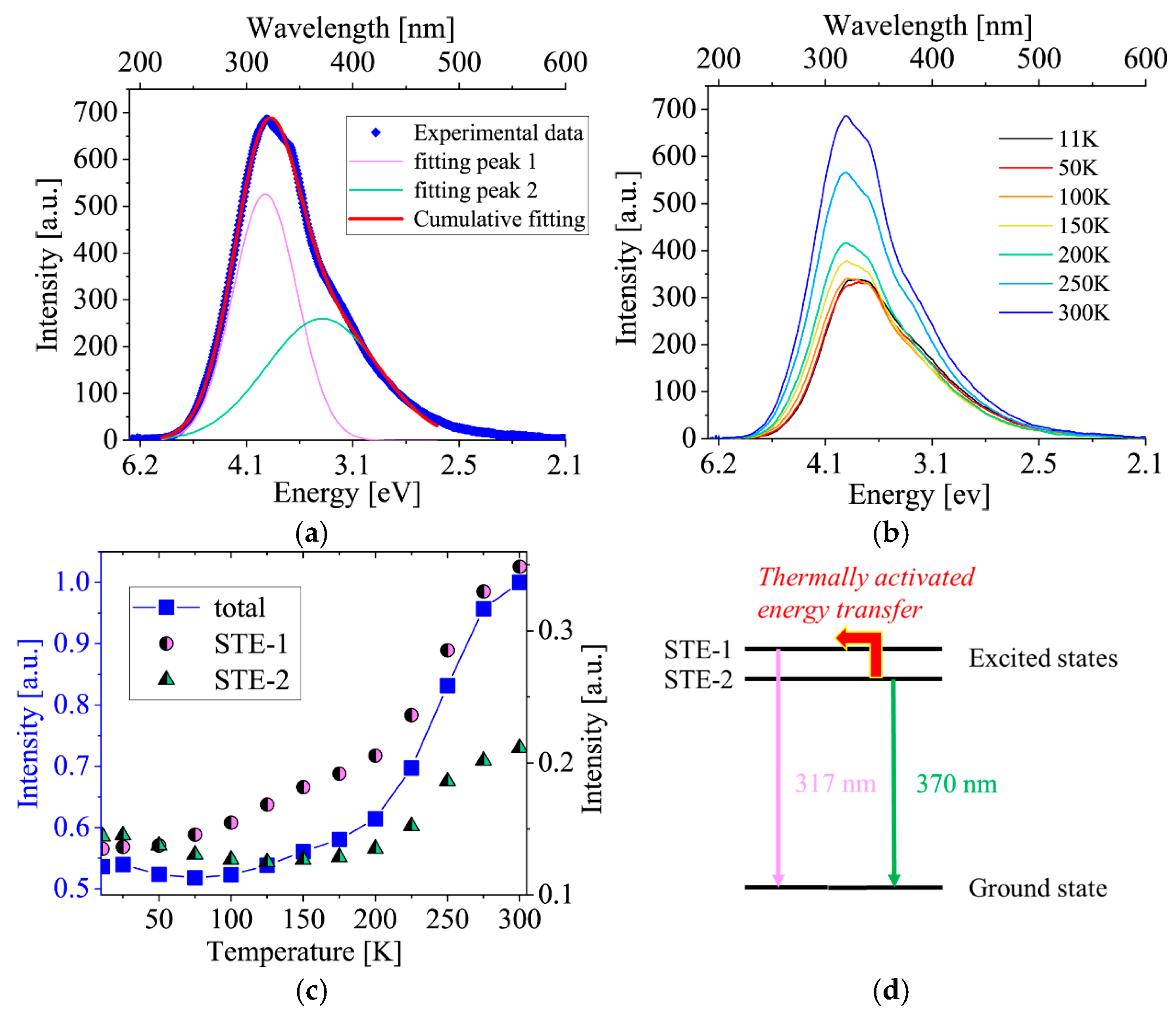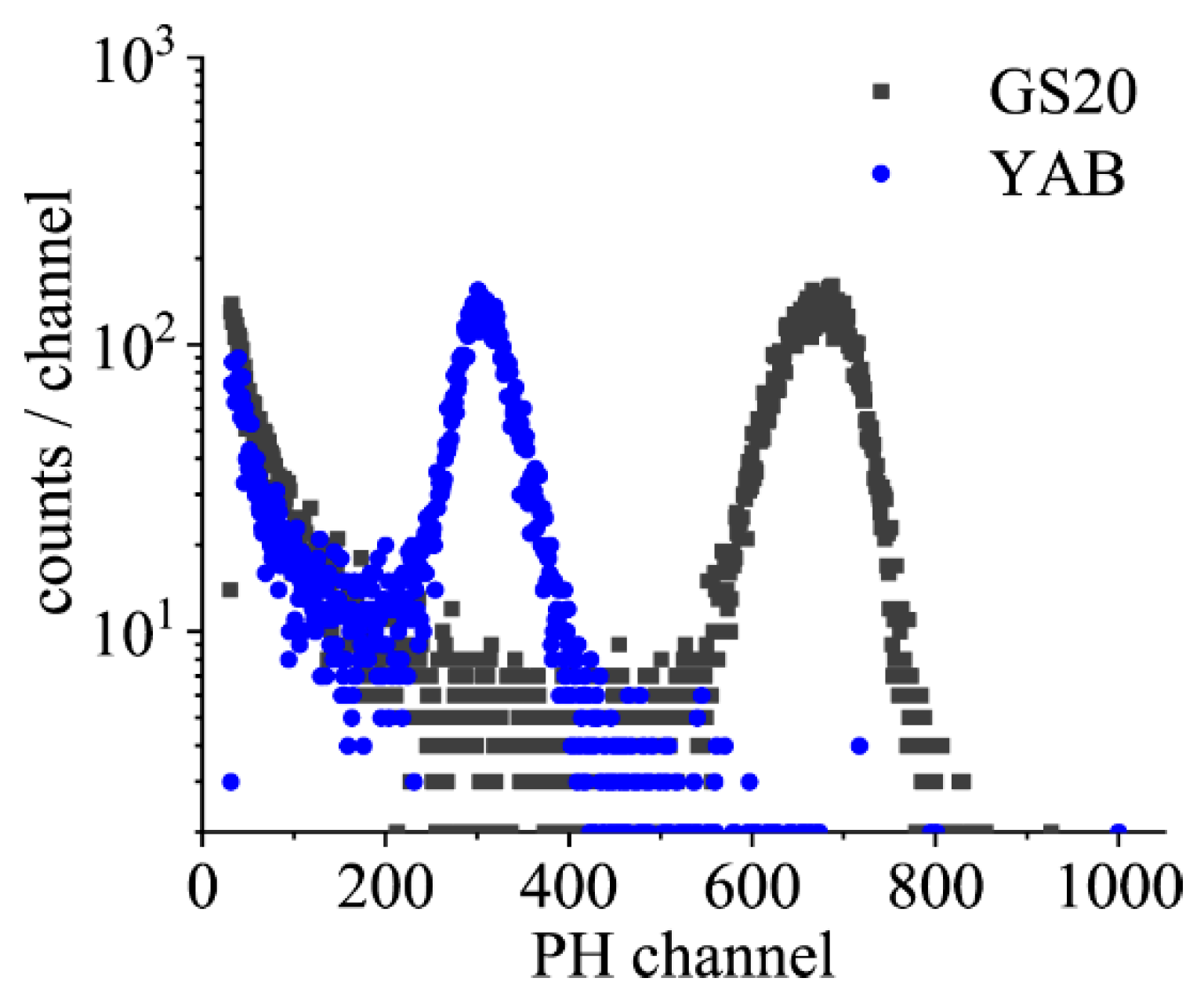Luminescence and Scintillation Properties of YAl3(BO3)4 Single Crystal for Thermal Neutron Detection
Abstract
:1. Introduction
2. Materials and Methods
3. Results
4. Conclusions
Author Contributions
Funding
Data Availability Statement
Conflicts of Interest
References
- van Eijk, C.W.E.; Bessière, A.; Dorenbos, P. Inorganic thermal-neutron scintillators. Nucl. Instrum. Meth. A 2004, 529, 260–267. [Google Scholar] [CrossRef]
- Kouzes, R.T.; Ely, J.H.; Erikson, L.E.; Kernan, W.J.; Lintereur, A.T.; Siciliano, E.R.; Stephens, D.L.; Stromswold, D.C.; Ginhoven, R.M.V.; Woodring, M.L. Neutron detection alternatives to 3He for national security applications. Nucl. Instrum. Meth. A 2010, 623, 1035–1045. [Google Scholar] [CrossRef]
- Trombetta, D.M.; Klintefjord, M.; Axell, K.; Cederwall, B. Fast neutron and γ-ray coincidence detection for nuclear security and safeguards applications. Nucl. Instrum. Meth. A 2019, 927, 119–124. [Google Scholar] [CrossRef]
- Piscitelli, F.; Mauri, G.; Laloni, A.; Hall-Wilton, R. Verification of He-3 proportional counters’ fast neutron sensitivity through a comparison with He-4 detectors. Eur. Phys. J. Plus 2020, 135, 577. [Google Scholar] [CrossRef]
- Pozzi, S.; Clarke, S.; Paff, M.; Di Fulvio, A.; Kouzes, R. Comparative neutron detection efficiency in He-3 proportional counters and liquid scintillators. Nucl. Instrum. Meth. A 2019, 929, 107–112. [Google Scholar] [CrossRef]
- Nelson, K.A.; Bellinger, S.L.; Montag, B.W.; Neihart, J.L.; Riedel, T.A.; Schmidt, A.J.; McGregor, D.S. Investigation of a lithium foil multi-wire proportional counter for potential 3He replacement. Nucl. Instrum. Meth. A 2012, 669, 79–84. [Google Scholar] [CrossRef]
- Murray, R. Use of Li6I(Eu) as a scintillation detector and spectrometer for fast neutrons. Nucl. Instrum. 1958, 2, 237–248. [Google Scholar] [CrossRef]
- Firk, F.W.K.; Slaughter, G.G.; Ginther, R.J. Improved Li6-Loaded Glass Scintillator for Neutron Detection. Nucl. Instrum. Methods 1961, 13, 313–316. [Google Scholar] [CrossRef]
- Knitel, M.J.; Dorenbos, P.; de Haas, J.T.M.; van Eijk, C.W.E. LiBaF3, a thermal neutron scintillator with optimal n-γ discrimination. Nucl. Instrum. Methods Phys. Res. A 1996, 374, 197–201. [Google Scholar] [CrossRef]
- Yanagida, T.; Kawaguchi, N.; Fujimoto, Y.; Fukuda, K.; Yokota, Y.; Yamazaki, A.; Watanabe, K.; Pejchal, J.; Uritani, A.; Iguchi, T.; et al. Basic study of Europium doped LiCaAlF6 scintillator and its capability for thermal neutron imaging application. Opt. Mater. 2011, 33, 1243–1247. [Google Scholar] [CrossRef]
- Iwanowska, J.; Swiderski, L.; Moszynski, M.; Yanagida, T.; Yokota, Y.; Yoshikawa, A.; Fukuda, K.; Kawaguchi, N.; Ishizu, S. Thermal neutron detection with Ce3+ doped LiCaAlF6 single crystals. Nucl. Instrum. Meth. A 2011, 652, 319–322. [Google Scholar] [CrossRef]
- Yanagida, T.; Kawaguchi, N.; Fujimoto, Y.; Fukuda, K.; Watanabe, K.; Yamazaki, A.; Uritani, A. Scintillation properties of LiF–SrF2 and LiF–CaF2 eutectic. J. Lumin. 2013, 144, 212–216. [Google Scholar] [CrossRef]
- Trojan-Piegza, J.; Glodo, J.; Sarin, V.K. CaF2(Eu2+):LiF—Structural and spectroscopic properties of a new system for neutron detection. Radiat. Meas. 2010, 45, 163–167. [Google Scholar] [CrossRef]
- Fujimoto, Y.; Kamada, K.; Yanagida, T.; Kawaguchi, N.; Kurosawa, S.; Totsuk, D.; Fukuda, K.; Watanabe, K.; Yamazaki, A.; Yokota, Y.; et al. Lithium Aluminate Crystals as Scintillator for Thermal Neutron Detection. IEEE Trans. Nucl. Sci. 2012, 59, 2252–2255. [Google Scholar] [CrossRef]
- Yanagida, T.; Fujimoto, Y.; Koshimizu, M.; Kawano, N.; Okada, G.; Kawaguchi, N. Comparative Studies of Optical and Scintillation Properties between LiGaO2 and LiAlO2 Crystals. J. Phys. Soc. Jpn. 2017, 86, 094201. [Google Scholar] [CrossRef]
- Bessiere, A.; Dorenbos, P.; van Eijk, C.W.E.; Krämer, K.W.; Güdel, H.U. Luminescence and scintillation properties of Cs2LiYCl6:Ce for γ and neutron detection. Nucl. Instrum. Methods Phys. Res. A 2005, 537, 242–246. [Google Scholar] [CrossRef]
- Hawrami, R.; Ariesanti, E.; Wei, H.; Finkelstein, J.; Glodo, J.; Shah, K. Tl2LiYCl6: Large Diameter, High Performing Dual Mode Scintillator. Cryst. Growth Des. 2017, 17, 3960–3964. [Google Scholar] [CrossRef]
- Kawaguchi, N.; Kawano, N.; Okada, G.; Yanagida, T. Luminescence and Scintillation Properties of LiF:W Single Crystal for Thermal-Neutron Detection. Sens. Mater. 2017, 29, 1431–1438. [Google Scholar]
- Song, Z.; Wang, J.; Tong, Y.; Zhang, Y.; Wang, Q.; Wang, C.; Ren, G.; Sun, X.; Wu, Y. Enhancement of alpha/beta ratio in NaI:Tl,6Li neutron-gamma scintillators by rare earth co-doping. Nucl. Instrum. Methods Phys. Res. A 2024, 1064, 169451. [Google Scholar] [CrossRef]
- Xie, A.; Hettiarachchi, C.; Maddalena, F.; Witkowski, M.E.; Makowski, M.; Drozdowski, W.; Arramel, A.; Wee, A.T.S.; Springham, S.V.; Vuong, P.Q.; et al. Lithium-doped two-dimensional perovskite scintillator for wide-range radiation detection. Commun. Mater. 2020, 1, 37. [Google Scholar] [CrossRef]
- Quang, N.D.; Vuong, P.Q.; Luan, N.T.; Truc, L.T.; Ton, N.D.; Kang, S.; Park, H.; Nam, U.-W.; Park, W.-K.; Sohn, J.; et al. Growth and characterization of 6LiI:Ag crystal scintillators for thermal and epithermal neutron detection on the lunar surface. J. Cryst. Growth 2024, 635, 127692. [Google Scholar] [CrossRef]
- Yuan, D.; Víllora, E.G.; Kawaguchi, N.; Nakauchi, D.; Kato, T.; Yanagida, T.; Shimamura, K. Thermal neutron scintillation improvement in Ce:Li6Y(BO3)3 single crystals by thermal treatment. Jpn. J. Appl. Phys. 2023, 62, 010614. [Google Scholar] [CrossRef]
- Wang, Q.; Wang, C.; Wang, Z.; Sun, X.; Nikl, M.; OuYang, X.; Wu, Y. Achieving Efficient Neutron and Gamma Discrimination in a Highly Stable 6Li-Loaded Cs3Cu2I5 Perovskite Scintillator. J. Phys. Chem. Lett. 2022, 13, 9066–9071. [Google Scholar] [CrossRef]
- Nasir, R.; Aziz, F.; Mirza, S.M.; Mirza, N.M. Experimental and theoretical study of BF3 detector response for thermal neutrons in reflecting materials. Nucl. Eng. Technol 2018, 50, 439–445. [Google Scholar] [CrossRef]
- Amaro, F.D.; Monteiro, C.M.B.; dos Santos, J.M.F.; Antognini, A. Novel concept for neutron detection: Proportional counter filled with 10B nanoparticle aerosol. Sci. Rep. 2017, 7, 41699. [Google Scholar] [CrossRef] [PubMed]
- Ballman, A.A. A new series of synthetic borates isostructural with the carbonate mineral huntite. Am. Mineral. 1962, 47, 1380–1383. [Google Scholar]
- Mills, A.D. Crystallographic Data for New Rare Earth Borate Compounds, RX3(BO3)4. Inorg. Chem. 1962, 1, 960–961. [Google Scholar] [CrossRef]
- Fan, M.; Wu, G.; Chen, F.; Yu, F.; Cheng, X.; Zhao, X. Electro-elastic features of Nd-doped YAl3(BO3)4 single crystal. Cryst. Eng. Comm. 2020, 22, 7816–7825. [Google Scholar] [CrossRef]
- Li, J.; Wang, J.; Cheng, X.; Hu, X.; Burns, P.; Dawes, J. Thermal and laser properties of Yb:YAl3(BO3)4 crystal. J. Cryst. Growth 2003, 250, 458–462. [Google Scholar] [CrossRef]
- Yokosawa, N.; Suzuki, K.; Nakazawa, E. Vacuum ultraviolet excitation processes of YAl3(BO3)4: R (R = Eu3+, Gd3+ and Tb3+). Jpn. J. Appl. Phys. 2003, 42, 5656–5659. [Google Scholar] [CrossRef]
- Yoshida, H.; Yoshimatsu, R.; Watanabe, S.; Ogasawara, K. Optical Transitions near the Fundamental Absorption Edge and Electronic Structures of YAl3(BO3)4:Gd3+. Jpn. J. Appl. Phys. 2006, 45, 146–151. [Google Scholar] [CrossRef]
- Cavalli, E.; Bovero, E.; Magnani, N.; Ramirez, M.O.; Speghini, A.; Bettinelli, M. Optical spectroscopy and crystal-field analysis of YAl3(BO3)4 single crystals doped with dysprosium. J. Phys. Condens. Matter 2003, 15, 1047–1056. [Google Scholar] [CrossRef]
- Dominiak-Dzik, G.; Ryba-Romanowski, W.; Kovács, L.; Beregi, E. Effect of temperature on luminescence and VUV to visible conversion in the YAl3(BO3)4:Dy3+ (YAB:Dy) crystal. Radiat. Meas. 2004, 38, 557–561. [Google Scholar] [CrossRef]
- Bartl, M.H.; Gatterer, K.; Cavalli, E.; Speghini, A.; Bettinelli, M. Growth, optical spectroscopy and crystal field investigation of YAl3(BO3)4 single crystals doped with tripositive praseodymium. Spectrochim. Acta Part A 2001, 57, 1981–1990. [Google Scholar] [CrossRef]
- Aloui-Lebbou, O.; Goutaudier, C.; Kubota, S.; Dujardin, C.; Cohen-Adad, M.T.; Pédrini, C.; Florian, P.; Massiot, D. Structural and scintillation properties of new Ce3+-doped alumino-borate. Opt. Mater. 2001, 16, 77–86. [Google Scholar] [CrossRef]
- Feofilov, S.; Zhou, Y.; Jeong, J.; Keszler, D.; Meltzer, R. Energy transfer from the host excitations to Ce3+ ions in scandium borate. J. Lumin. 2007, 125, 80–84. [Google Scholar] [CrossRef]
- Fujimoto, Y.; Yanagida, T.; Yokota, Y.; Kawaguchi, N.; Fukuda, K.; Totsuka, D.; Watanabe, K.; Yamazaki, A.; Yoshikawa, A. Growth and characterization of strontium metaborate scintillators. Opt. Mater. 2011, 34, 444–447. [Google Scholar] [CrossRef]
- Fujimoto, Y.; Yanagida, T.; Kawaguchi, N.; Fukuda, K.; Totsuka, D.; Watanabe, K.; Yamazaki, A.; Chani, V.; Nikl, M.; Yoshikawa, A. Crystal growth and characterization of calcium metaborate scintillators. Nucl. Instrum. Methods Phys. Res. A 2013, 703, 7–10. [Google Scholar] [CrossRef]
- Yanagida, T.; Kimura, H.; Nakauchi, D.; Kato, T.; Kawaguchi, N. Photoluminescence and scintillation characteristics of b-BaB2O4 single crystal. Jpn. J. Appl. Phys. 2020, 59, 102004. [Google Scholar] [CrossRef]
- Kawaguchi, N.; Okada, G.; Futami, Y.; Nakauchi, D.; Kato, T.; Yanagida, T. Scintillation and Dosimetric Properties of Monocrystalline and Polycrystalline Li2B4O7. Sens. Mater. 2020, 32, 1419–1426. [Google Scholar] [CrossRef]
- Fukui, K.; Miura, H.; Nakagawa, H.; Shimoyama, I.; Nakagawa, K.; Okamura, H.; Nanba, T.; Hasumoto, M.; Kinoshita, T. Performance of IR-VUV normal incidence monochromator beamline at UVSOR. Nucl. Instrum. Methods Phys. Res. A 2001, 467–468, 601–604. [Google Scholar] [CrossRef]
- Koshimizu, M.; Onodera, K.; Nishikido, F.; Haruki, R.; Shibuya, K.; Kishimoto, S.; Asai, K. X-ray detection capability of a BaCl2 single crystal scintillator. J. Appl. Phys. 2012, 111, 024906. [Google Scholar] [CrossRef]
- Yanagida, T.; Fujimoto, Y.; Yagi, H.; Yanagitani, T. Optical and scintillation properties of transparent ceramic Yb:Lu2O3 with different Yb concentrations. Opt. Mater. 2014, 36, 1044–1048. [Google Scholar] [CrossRef]
- Moszyixki, M.; Kapusta, M.; Mayhugh, M.; Wolski, D.; Flyckt, S.O. Absolute light output of scintillators. IEEE Trans. Nucl. Sci. 1997, 44, 1052–1061. [Google Scholar] [CrossRef]
- van Eijk, C.W.E. Inorganic Scintillators for Thermal Neutron Detection. Rad. Meas. 2004, 38, 337–342. [Google Scholar] [CrossRef]
- Yu, X.; Yue, Y.; Yao, J.; Hu, Z.-G. YAl3(BO3)4: Crystal growth and characterization. J. Cryst. Growth 2010, 312, 3029–3033. [Google Scholar] [CrossRef]
- Yoshida, H.; Fujikawa, K.; Toyoshima, H.; Watanabe, S.; Ogasawara, K. Luminescence properties of YAl3(BO3)4 substituted with Sc3+ ions. Phys. Stat. Sol. A 2006, 203, 2701–2704. [Google Scholar] [CrossRef]
- Koshimizu, M.; Saeki, K.; Fujimoto, Y.; Okada, G.; Yanagida, T.; Yamashita, S.; Asai, K. A three-state model for describing the temperature variation of the scintillation properties of Cs2HfCl6. Jpn. J. Appl. Phys. 2018, 57, 032401. [Google Scholar] [CrossRef]
- Wolszczak, W.W.; Dorenbos, P. Nonproportional Response of Scintillators to Alpha Particle Excitation. IEEE Trans. Nucl. Sci. 2017, 64, 1580–1591. [Google Scholar]
- Fawad, U.; Rooh, G.; Kim, H.J.; Park, H.; Kim, S.; Khan, S. Scintillation properties of Li6Y0.5Gd0.5(BO3)3: Ce3+ single crystal. J. Cryst. Growth 2015, 410, 18–22. [Google Scholar] [CrossRef]
- Fujimoto, Y.; Yanagida, T.; Kawaguchi, N.; Kurosawa, S.; Fukuda, K.; Totsuka, D.; Watanabe, K.; Yamazaki, A.; Yokota, Y.; Yoshikawa, A. Characterizations of Ce3+-Doped CaB2O4 Crystalline Scintillator. Cryst. Growth Des. 2012, 12, 142–146. [Google Scholar] [CrossRef]





| Borate Scintillator | Scintillation Wavelength [nm] | Light Yield [ph/nth] |
|---|---|---|
| CaB2O4 | 300–400 | 3200 |
| SrB2O4 | 300, 375 | 1500 |
| CaB2O4:Ce (0.5%) | 300, 375 | 2200 |
| SrB2O4:Ce (0.5%) | 300–400 | 1000 |
| YAl3(BO3)4 | 317, 370 | 2700 |
Disclaimer/Publisher’s Note: The statements, opinions and data contained in all publications are solely those of the individual author(s) and contributor(s) and not of MDPI and/or the editor(s). MDPI and/or the editor(s) disclaim responsibility for any injury to people or property resulting from any ideas, methods, instructions or products referred to in the content. |
© 2025 by the authors. Licensee MDPI, Basel, Switzerland. This article is an open access article distributed under the terms and conditions of the Creative Commons Attribution (CC BY) license (https://creativecommons.org/licenses/by/4.0/).
Share and Cite
Fujimoto, Y.; Koshimizu, M.; Kawamoto, H.; Watanabe, K.; Miyamoto, A.; Asai, K. Luminescence and Scintillation Properties of YAl3(BO3)4 Single Crystal for Thermal Neutron Detection. Crystals 2025, 15, 357. https://doi.org/10.3390/cryst15040357
Fujimoto Y, Koshimizu M, Kawamoto H, Watanabe K, Miyamoto A, Asai K. Luminescence and Scintillation Properties of YAl3(BO3)4 Single Crystal for Thermal Neutron Detection. Crystals. 2025; 15(4):357. https://doi.org/10.3390/cryst15040357
Chicago/Turabian StyleFujimoto, Yutaka, Masanori Koshimizu, Hiroki Kawamoto, Kenichi Watanabe, Akio Miyamoto, and Keisuke Asai. 2025. "Luminescence and Scintillation Properties of YAl3(BO3)4 Single Crystal for Thermal Neutron Detection" Crystals 15, no. 4: 357. https://doi.org/10.3390/cryst15040357
APA StyleFujimoto, Y., Koshimizu, M., Kawamoto, H., Watanabe, K., Miyamoto, A., & Asai, K. (2025). Luminescence and Scintillation Properties of YAl3(BO3)4 Single Crystal for Thermal Neutron Detection. Crystals, 15(4), 357. https://doi.org/10.3390/cryst15040357






